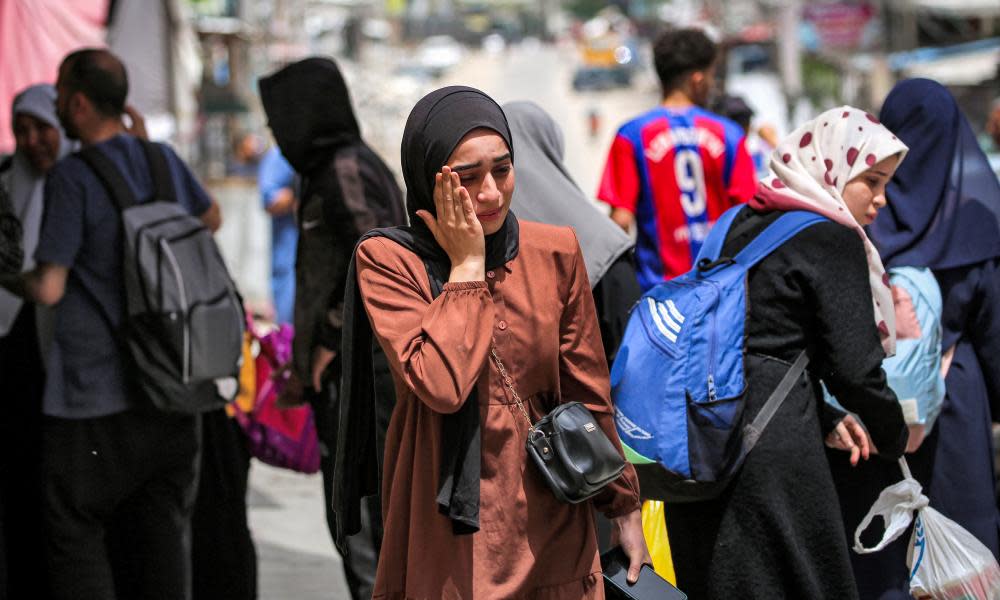Israel orders central Rafah residents to evacuate as major offensive looms

The Israeli military has told residents of central Rafah to evacuate, signalling a major expansion of its military operations in the city and threatening the displacement of hundreds of thousands more people.
The Israel Defense Forces (IDF) seized the Rafah border crossing with Egypt last week in what it said was a “precise, targeted operation” after ordering the evacuation of eastern neighbourhoods. More than 150,000 people have already fled the southern city in Gaza.
The new instructions to residents, via leaflets and messages on social media, suggest a coming offensive will take the IDF into the centre of Rafah and on to a likely advance through the entire city.
On Saturday morning, Israeli tanks were positioned on Salahuddin Road which divides central Rafah from the already evacuated eastern neighbourhoods, witnesses said.
Benjamin Netanyahu, the Israeli prime minister, has rejected US pressure to hold off an attack on Rafah, saying Hamas has based most of its top leaders and remaining forces there.
#عاجل 🔴 نداء إلى جميع السكان والنازحين المتواجدين في منطقة جباليا وأحياء السلام والنور وتل الزعتر ومشروع بيت لاهيا ومعسكر جباليا وعزبة ملين والروضة, والنزهة, الجرن، النهضة، والزهور - توجهوا فورًا إلى المآوي غرب مدينة غزة!
⭕️تتواجدون في منطقة قتال خطيرة. تحاول حماس إعمار… pic.twitter.com/oFYipXMajx— افيخاي ادرعي (@AvichayAdraee) May 11, 2024
The IDF also dropped leaflets over a large area of northern Gaza, calling for the evacuation of “all residents and displaced people” from neighbourhoods in Gaza City, Jabaliya, Zeitoun and Beit Lahiya. All of these areas have come under repeated bombardment and fighting in recent months, underlining the difficulties faced by Israeli military forces as they attempt to eradicate Hamas.
The IDF said in a statement: “Following attempts by Hamas to reassemble its terrorist infrastructure and operatives in the area, this morning [Saturday], the IDF called on the civilian population of Jabaliya and the surrounding areas to temporarily evacuate to shelters in western Gaza City. This is in order to reduce harm to the civilian population and to move civilians away from the combat zone, in accordance with international law.”
Related: Latest Gaza evacuation warnings expose weak spots in Israel’s war strategy
Many of those fleeing Rafah were heading for the “expanded humanitarian zone”, designated by the IDF at al-Mawasi on the coast, where aid workers said conditions were already “horrific”.
In the west of Rafah, where about a million people were sheltering after being displaced from elsewhere in Gaza during the seven-month war, many were already planning to leave.
“We are now in a state of extreme tension and anxiety,” said Dina Zayed, 54, who has been living in Rafah for six months since being forced to flee the north of Gaza shortly after the outbreak of the war.
“We don’t know what will happen to us. We are going towards the unknown. Everyone feels the same. Our coming days will be difficult.”
Muhammad Qahman, 54, said he was concerned about conditions at al-Mawasi, a strip of sandy coast and dunes that is packed with hundreds of thousands of displaced people who have overwhelmed the entirely inadequate supplies of food, clean water and healthcare. Sanitation systems barely exist, leading to the rapid spread of disease.
“We don’t know what we will do. We are now preparing our things to go to the area designated by the Israeli army, which is supposed to be safe and a humanitarian area, but this is just a lie,” said Qahman, who has been living in Rafah since January.
The closure of the Rafah border crossing to Egypt, the difficulties of reaching the Kerem Shalom crossing because of the fighting, a lack of transport because of fuel shortages and the flight of key workers mean almost no aid is reaching southern and central Gaza. Humanitarian organisations have been the only source of food and medical services for much of the city’s population for many months but are now shutting down services.
Aid agencies said on Friday they had less than 48 hours’ worth of fuel supplies.
So far, more than 34,800 Palestinians, mainly women and children, have been killed during the Israeli offensive, which was launched after Hamas killed about 1,200 people, mostly civilians, and took 250 hostages in a surprise attack on southern Israel in October.
About 132 Israeli hostages are believed to remain in Gaza, though up to half may now be dead.
Israeli officials told the Ynet news site that hostage and ceasefire negotiations between Israel and Hamas had not completely broken down. Indirect talks would resume “if there are answers from Hamas that we can work with”, the officials told the site.
Hamas said on Friday that efforts to find a deal on a truce were back at square one after Israel rejected a plan from international mediators, while the White House expressed its commitment to try keeping the sides engaged “if only virtually”.
On Saturday, Hamas released the latest in a series of videos of hostages it is still holding. The short clip showed a 52-year-old man who identified himself by name and appeared to show signs of having been physical abused. Israel has condemned the tactic as “cruel psychological propaganda”.


